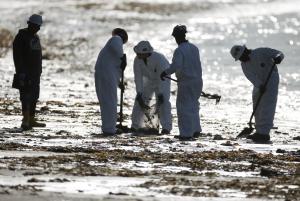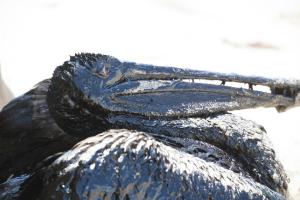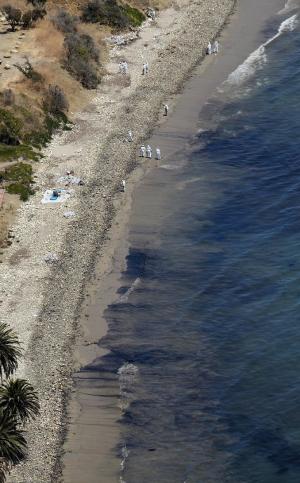GOLETA, Calif. (AP) — The latest oil spill on the Santa Barbara coast is just a drop in the bucket compared with the area's catastrophic blowout in 1969, but it has become a new rallying point for environmentalists in their battle against drilling and fossil fuels.
No one expects damage on the order of the '69 disaster, which helped give rise to the modern environmental movement and led to passage of some of the nation's most important environmental laws.
Nevertheless, the new spill from a ruptured underground pipe is being held up as another reason to oppose such things as fracking, the Keystone XL pipeline that would run from Canada to Texas, the moving of crude by train, and drilling in far-flung places.
"What we see from this event is that the industry still poses enormous risks to an area we cannot afford to lose," said Joel Reynolds of the Natural Resources Defense Council.
The timing of the leak — days after a federal agency approved Shell's plan for drilling in the Arctic, and while the Obama administration considers opening the Atlantic to exploration — could work to the advantage of environmental groups.
Closer to home, it could galvanize opposition to plans for new drilling in the Santa Barbara Channel, where Union Oil's platform blew out 46 years ago, spewing an estimated 3 million gallons of crude along 30 miles of coast. Some 9,000 birds died.
View gallery

Workers clean up an oil slick along the coast of Refugio State Beach in Goleta, California, United S …
Tuesday's spill involved an estimated 105,000 gallons of crude; about 21,000 is believed to have made it to the sea and split into slicks that stretched 9 miles along the same stretch of coast fouled in 1969. A 23-mile by 7-mile area was closed to fishing.
As of Thursday, more than 9,000 gallons had been raked, skimmed and vacuumed up, officials said.
The thick, powerful-smelling crude coated rocks and sand, but only six oil-coated pelicans and one juvenile sea lion had been rescued.
There was no estimate on the cost of the cleanup.
The 24-inch pipe, built in 1987, had no previous problems and was thoroughly inspected in 2012, according to its operator, Plains All American Pipeline. The pipe underwent similar tests about two weeks ago, though the results had not been analyzed yet.
Company officials said it can take weeks or months after excavation and inspection of the broken pipeline to determine the cause of the spill.
The 1969 spill was a watershed event in the area and also for the nation.
Artist Bud Bottoms remembers yelling, "We've got to get oil out!" thus coining what became a rallying cry and the name of the organization he founded, Get Oil Out, or GOO.
"We made so much noise about the oil spill in our pristine Santa Barbara coast that it was called the 'environmental shot heard 'round the world,'" Bottoms said.
The stench was terrible, and he remembers people crying at the sight of the beaches. Inmates were brought in to help spread bales of straw to sop up the mess.
View gallery

A pelican covered in oil sits on a beach about a mile west of Refugio State Beach, Calif., Wednesday …
His group helped gather 200,000 signatures to get the oil rigs removed from the coast. That never happened, but over the next few years significant legislation was passed to protect endangered species and the air and water. The first Earth Day was celebrated in 1970.
Sean Anderson, environmental professor at California State University, Channel Islands, said he doesn't think this week's spill will have any effect on policies or regulations, mostly because there are so many already in place.
"The 1969 spill created a panoply of federal, state and county level regulations and laws," he said. "From that watershed event, a huge array of policy and procedural tools emerged."
Tupper Hull, a spokesman with Western States Petroleum Association, said the industry expects a certain amount of blowback but not necessarily new regulation.
"It's no secret that there are groups that have an agenda to curtail energy production in California," Hull said. "They will no doubt reference this tragedy in their advocacy. We will respond with a measured, thoughtful response that will make full use of facts."
View gallery

Clean-up crews work at the site of an oil spill at Refugio State Beach, north of Goleta, Calif., Wed …
Plains All American and its subsidiaries operate more than 6,000 miles of hazardous liquid pipelines in at least 20 states, according to company reports. Those companies handle more than 4 million barrels of crude and other liquid fuels daily.
Since 2006, the companies have reported 199 accidents and been subject to 22 enforcement actions by federal regulators. The accidents resulted in a combined 725,500 gallons of hazardous liquids spilled and damage topping $25 million.
Corrosion was determined to be the cause in more than 80 of those accidents. Failures in materials, welds and other equipment were cited more than 70 times.
Enforcement cases against the companies resulted in the collection of $154,000 in penalties, according to a federal database.
Patrick Hodgins, senior director of safety for Plains All American, said the company has spent more than $1.3 billion since 2007 on maintenance, repair and enhancement of its equipment.
"Safety is not just a priority; it's actually a core value at Plains," he said.
One local group that arose out of the 1969 disaster was the local Environmental Defense Center, which is now trying to block certain drilling projects.
"It doesn't matter how many laws you have on the books or how many regulations you have and it doesn't matter what advancements are made in technology," said Linda Krop, the group's chief counsel. "Oil development is risky business and will result in oil spills."
___
Associated Press writers John Antczak in Los Angeles and Matthew Brown in Billings, Montana, contributed to this story.GOLETA, Calif. (AP) — The latest oil spill on the Santa Barbara coast is just a drop in the bucket compared with the area's catastrophic blowout in 1969, but it has become a new rallying point for environmentalists in their battle against drilling and fossil fuels.
No one expects damage on the order of the '69 disaster, which helped give rise to the modern environmental movement and led to passage of some of the nation's most important environmental laws.
Nevertheless, the new spill from a ruptured underground pipe is being held up as another reason to oppose such things as fracking, the Keystone XL pipeline that would run from Canada to Texas, the moving of crude by train, and drilling in far-flung places.
"What we see from this event is that the industry still poses enormous risks to an area we cannot afford to lose," said Joel Reynolds of the Natural Resources Defense Council.
The timing of the leak — days after a federal agency approved Shell's plan for drilling in the Arctic, and while the Obama administration considers opening the Atlantic to exploration — could work to the advantage of environmental groups.
Closer to home, it could galvanize opposition to plans for new drilling in the Santa Barbara Channel, where Union Oil's platform blew out 46 years ago, spewing an estimated 3 million gallons of crude along 30 miles of coast. Some 9,000 birds died.
View gallery

Workers clean up an oil slick along the coast of Refugio State Beach in Goleta, California, United S …
Tuesday's spill involved an estimated 105,000 gallons of crude; about 21,000 is believed to have made it to the sea and split into slicks that stretched 9 miles along the same stretch of coast fouled in 1969. A 23-mile by 7-mile area was closed to fishing.
As of Thursday, more than 9,000 gallons had been raked, skimmed and vacuumed up, officials said.
The thick, powerful-smelling crude coated rocks and sand, but only six oil-coated pelicans and one juvenile sea lion had been rescued.
There was no estimate on the cost of the cleanup.
The 24-inch pipe, built in 1987, had no previous problems and was thoroughly inspected in 2012, according to its operator, Plains All American Pipeline. The pipe underwent similar tests about two weeks ago, though the results had not been analyzed yet.
Company officials said it can take weeks or months after excavation and inspection of the broken pipeline to determine the cause of the spill.
The 1969 spill was a watershed event in the area and also for the nation.
Artist Bud Bottoms remembers yelling, "We've got to get oil out!" thus coining what became a rallying cry and the name of the organization he founded, Get Oil Out, or GOO.
"We made so much noise about the oil spill in our pristine Santa Barbara coast that it was called the 'environmental shot heard 'round the world,'" Bottoms said.
The stench was terrible, and he remembers people crying at the sight of the beaches. Inmates were brought in to help spread bales of straw to sop up the mess.
View gallery

A pelican covered in oil sits on a beach about a mile west of Refugio State Beach, Calif., Wednesday …
His group helped gather 200,000 signatures to get the oil rigs removed from the coast. That never happened, but over the next few years significant legislation was passed to protect endangered species and the air and water. The first Earth Day was celebrated in 1970.
Sean Anderson, environmental professor at California State University, Channel Islands, said he doesn't think this week's spill will have any effect on policies or regulations, mostly because there are so many already in place.
"The 1969 spill created a panoply of federal, state and county level regulations and laws," he said. "From that watershed event, a huge array of policy and procedural tools emerged."
Tupper Hull, a spokesman with Western States Petroleum Association, said the industry expects a certain amount of blowback but not necessarily new regulation.
"It's no secret that there are groups that have an agenda to curtail energy production in California," Hull said. "They will no doubt reference this tragedy in their advocacy. We will respond with a measured, thoughtful response that will make full use of facts."
View gallery

Clean-up crews work at the site of an oil spill at Refugio State Beach, north of Goleta, Calif., Wed …
Plains All American and its subsidiaries operate more than 6,000 miles of hazardous liquid pipelines in at least 20 states, according to company reports. Those companies handle more than 4 million barrels of crude and other liquid fuels daily.
Since 2006, the companies have reported 199 accidents and been subject to 22 enforcement actions by federal regulators. The accidents resulted in a combined 725,500 gallons of hazardous liquids spilled and damage topping $25 million.
Corrosion was determined to be the cause in more than 80 of those accidents. Failures in materials, welds and other equipment were cited more than 70 times.
Enforcement cases against the companies resulted in the collection of $154,000 in penalties, according to a federal database.
Patrick Hodgins, senior director of safety for Plains All American, said the company has spent more than $1.3 billion since 2007 on maintenance, repair and enhancement of its equipment.
"Safety is not just a priority; it's actually a core value at Plains," he said.
One local group that arose out of the 1969 disaster was the local Environmental Defense Center, which is now trying to block certain drilling projects.
"It doesn't matter how many laws you have on the books or how many regulations you have and it doesn't matter what advancements are made in technology," said Linda Krop, the group's chief counsel. "Oil development is risky business and will result in oil spills."
___
Associated Press writers John Antczak in Los Angeles and Matthew Brown in Billings, Montana, contributed to this story.